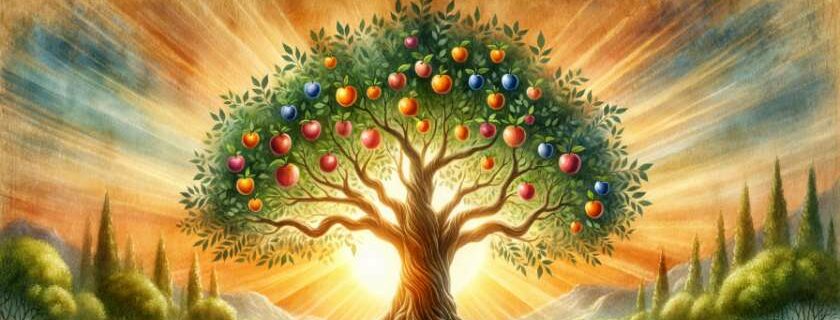The Tree of Life is located in the Garden of Eden alongside the Tree of Knowledge of Good and Evil. Trees are commonly regarded as a source of energy in the human world, and their fruits provide life to mankind.
The Tree of Life represents physical and spiritual nourishment in the Bible. It bears lovely, delectable fruit; through the Tree of Life, one can gain access to the fullness of everlasting life and reliance on the Lord through his Holy Spirit.
Its presence in the Bible’s earliest narratives sets a foundational theme for understanding the relationship between God, humanity, and the sanctity of life. What is the real meaning behind the ‘Tree of Life’ according to the Scriptures?
Key Takeaways
- The Tree of Life symbolizes both physical and spiritual nourishment, embodying God’s life-giving presence and eternal life.
- Featured in the Garden of Eden story, it stands alongside the Tree of Knowledge of Good and Evil, integral to humanity’s early spiritual journey.
- In the New Testament, particularly in Revelation, the Tree of Life represents Christ and the promise of eternal life to those overcoming sin.
Contents
What Is The Tree Of Life?
The Tree of Life is undoubtedly a crucial element in the Garden of Eden. The Tree of Life[1], first mentioned in Genesis, is a life-giving tree designed to support the physical and spiritual well-being of mankind.
“The LORD God made all sorts of trees grow up from the ground—beautiful trees that produced delicious fruit. In the middle of the garden, he placed the Tree of Life and the Tree of the Knowledge of Good and Evil.”
— Genesis 2:9
In the Book of Genesis, God places the Tree of Life and the Tree of Knowledge of Good and Evil in the middle of the Garden of Eden, where the Tree of Life exists as a symbol of God’s life-giving presence and the fullness of everlasting life accessible in God. The Tree of Life represents the fellowship and reliance of Adam and Eve on God, in which the fullness of eternal life could only be maintained through obedience to God’s commands.

What Is The Bible Meaning Of The Tree Of Life?
The tree is a life-giving tree created by God and was described as bearing beautiful, delectable fruit and standing prominently in the center of Eden’s garden. It is the source of both physical and spiritual life. To live forever, mankind needed to eat from the Tree of Life.
But the LORD God warned him [Adam], “You may freely eat the fruit of every tree in the garden—except the tree of the knowledge of good and evil. If you eat its fruit, you are sure to die” (Genesis 2:16–17).
Satan has persuaded Eve to doubt God’s words and goodness. Eve ate the fruit and gave it to Adam, who also ate it. Adam and Eve were expelled from the garden and away from the Tree of Life, and they lost their eternal life after disobeying God by eating from the Tree of the Knowledge of Good and Evil.
“Behold, the man has become like one of us in knowing good and evil; now, lest he reach out his hand and take also of the Tree of Life and eat and live forever,” the Lord God expelled him from Eden to work the ground from which he was taken, and he placed cherubim and a flaming sword that turned every way to guard the way to the Tree of Life.
God expelled them because He did not want them to eat from the Tree of Life and live forever in sin. The physical path to eternal life has been cut off. Because earthly life would be filled with sorrow and toil due to sin, God graciously limited the number of years that human beings would live. To live forever in a sinful state would mean endless agony for humanity, with no hope of relief from death. The only way is to follow Jesus Christ.
The Tree of Life is also a representation of the Lord Himself: “I am the vine; you are the branches. Whoever abides in me and I in him, he it is that bears fruit, for apart from me you can do nothing” (John 15:5).
The Tree Of Life In The New Testament
The Tree of Life is mentioned in the New Testament in the middle and end of the Book of Revelation, where we get a clear picture of its meaning and importance to God and His people.
In Revelation 2:7, Jesus Christ invites church members to hear what the Holy Spirit has to say to the church. The letters to the churches were messages sent by Jesus through John that the Holy Spirit inspired.
“Anyone with ears to hear must listen to the Spirit and understand what he is saying to the churches. To everyone who is victorious, I will give fruit from the Tree of Life in the paradise of God.”
In verse 7, Jesus promises to grant every conqueror the privilege of partaking in the Tree of Life in God’s paradise. The Tree of Life first appears in the Garden of Eden (Genesis 2:9; 3:22, 24) and is mentioned again in Revelation 22. The promise of heaven would persuade the conquerors to follow Jesus’ commands.
“Blessed are those who wash their robes. They will be permitted to enter through the gates of the city and eat the fruit from the Tree of Life” (Revelation 22:14, NLT). The washing of robes is a metaphor for detoxification from uncleanliness or sin.
In Revelation 22:1-3, a river as clear as crystal flows from the throne of God and the Lamb in New Jerusalem. Moreover, the Tree of Life represents Christ Himself, providing immortality. It fulfills the Tree of Life in Paradise and the other trees of life.
“Then the angel showed me the river of the water of life, bright as crystal, flowing from the throne of God and of the Lamb through the middle of the street of the city; also, on either side of the river, the Tree of Life with its twelve kinds of fruit, yielding its fruit each month. The leaves of the tree were for the healing of the nations. No longer will there be anything accursed, but the throne of God will be in it, and his servants will worship him.
What Is The Importance Of The Tree Of Life Today?
When God created Adam and Eve, they were perfect in every way and lived in paradise. God created man in His image, which means they had the freedom to make their own decisions and choices. However, Adam and Eve disobeyed God, and due to the sinful nature we inherited from them, all mankind is subject to physical and eternal death.
According to the Lord, all who sin will die, physically and spiritually, which is humanity’s fate. But, in His grace and mercy, God sacrificed His one and only son, Jesus. God declared that “without the shedding of blood, there is no forgiveness” (Hebrews 9:22), but redemption is provided through the shedding of blood.
The Tree of Life appears to be the way for us to have the ability to distinguish between good and evil and the free will to choose between the life-giving Christ and the deadly pursuit of selfish passion. As humans, eternal life will be granted through Him and to those who accept and believe in Christ. Faith and belief are the keys to our salvation.

Summary
God created the Tree of Life as a symbol of physical and spiritual nourishment. To live eternally, mankind must have access to the Tree of Life. However, because Adam and Eve disobeyed God, He showed compassion by barring access to the Tree of Life to prevent Adam and Eve from living forever in disobedience and sin.
Jesus Christ is the Tree of Life. God is the source and sustainer of all life. The Tree of Life teaches us that our true enemy is the devil, who tempts us and desires our destruction. Obedience is our way of expressing our love for God, and it is through our obedience that God recognizes us and allows us to enjoy His love.
Frequently Asked Questions
What Does The Tree Of Life Symbolize In Christianity?
The Tree of Life in Christianity symbolizes eternal life, spiritual nourishment, and the life-giving presence of God.
What Is The Purpose Of The Tree Of Life?
The purpose of the Tree of Life is to represent the possibility of immortality and a life in close communion with God.
What Does A Tree Symbolize In The Bible?
A tree in the Bible generally symbolizes growth, life, and sustenance, often with spiritual connotations.
Is Jesus Referred To As The Tree Of Life?
Jesus is not directly referred to as the Tree of Life in the Bible. However, some interpretations link the symbolism of the Tree of Life to the redemptive role of Jesus Christ, especially in the context of eternal life.
